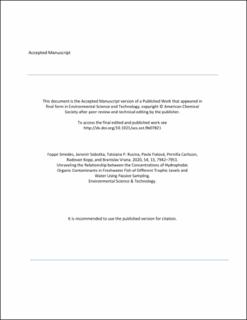| dc.contributor.author | Smedes, Foppe | |
| dc.contributor.author | Sobotka, Jaromír | |
| dc.contributor.author | Rusina, Tatsiana P | |
| dc.contributor.author | Fialová, Pavla | |
| dc.contributor.author | Carlsson, Pernilla Marianne | |
| dc.contributor.author | Kopp, Radovan | |
| dc.contributor.author | Vrana, Branislav | |
| dc.date.accessioned | 2020-07-10T10:41:04Z | |
| dc.date.available | 2020-07-10T10:41:04Z | |
| dc.date.created | 2020-07-06T08:02:49Z | |
| dc.date.issued | 2020 | |
| dc.identifier.citation | Environmental Science & Technology. 2020, 54 (13), 7942-7951 | en_US |
| dc.identifier.issn | 0013-936X | |
| dc.identifier.uri | https://hdl.handle.net/11250/2663690 | |
| dc.description | Embargo until 18 June 2021 | en_US |
| dc.description.abstract | The concentrations of hydrophobic organic compounds (HOCs) in aquatic biota are used for compliance, as well as time and spatial trend monitoring in the aqueous environment (European Union water framework directive, OSPAR). Because of trophic magnification in the food chain, the thermodynamic levels of HOCs, for example, polychlorinated biphenyl congeners, dichlorodiphenyltrichloroethane, and brominated diphenyl ether congeners, in higher trophic level (TL) organisms are expected to be strongly elevated above those in water. This work compares lipid-based concentrations at equilibrium with the water phase derived from aqueous passive sampling (CL⇌water) with the lipid-based concentrations in fillet and liver of fish (CL) at different TLs for three water bodies in the Czech Republic and Slovakia. The CL values of HOCs in fish were near CL⇌water, only after trophic magnification up to TL = 4. For fish at lower TL, CL progressively decreased relative to CL⇌water as KOW of HOCs increased above 106. The CL value decreasing toward the bottom of the food chain suggests nonequilibrium for primary producers (algae), which is in agreement with modeling passive HOC uptake by algae. Because trophic magnification and the resulting CL in fish exhibit large natural variability, CL⇌water is a viable alternative for monitoring HOCs using fish, showing a twofold lower confidence range and requiring less samples. | en_US |
| dc.language.iso | eng | en_US |
| dc.publisher | American Chemical Society | en_US |
| dc.title | Unraveling the Relationship between the Concentrations of Hydrophobic Organic Contaminants in Freshwater Fish of Different Trophic Levels and Water Using Passive Sampling | en_US |
| dc.type | Peer reviewed | en_US |
| dc.type | Journal article | en_US |
| dc.description.version | acceptedVersion | en_US |
| dc.source.pagenumber | 7942–7951 | en_US |
| dc.source.volume | 54 | en_US |
| dc.source.journal | Environmental Science and Technology | en_US |
| dc.source.issue | 13 | en_US |
| dc.identifier.doi | 10.1021/acs.est.9b07821 | |
| dc.identifier.cristin | 1818637 | |
| cristin.ispublished | true | |
| cristin.fulltext | postprint | |
| cristin.qualitycode | 2 | |
